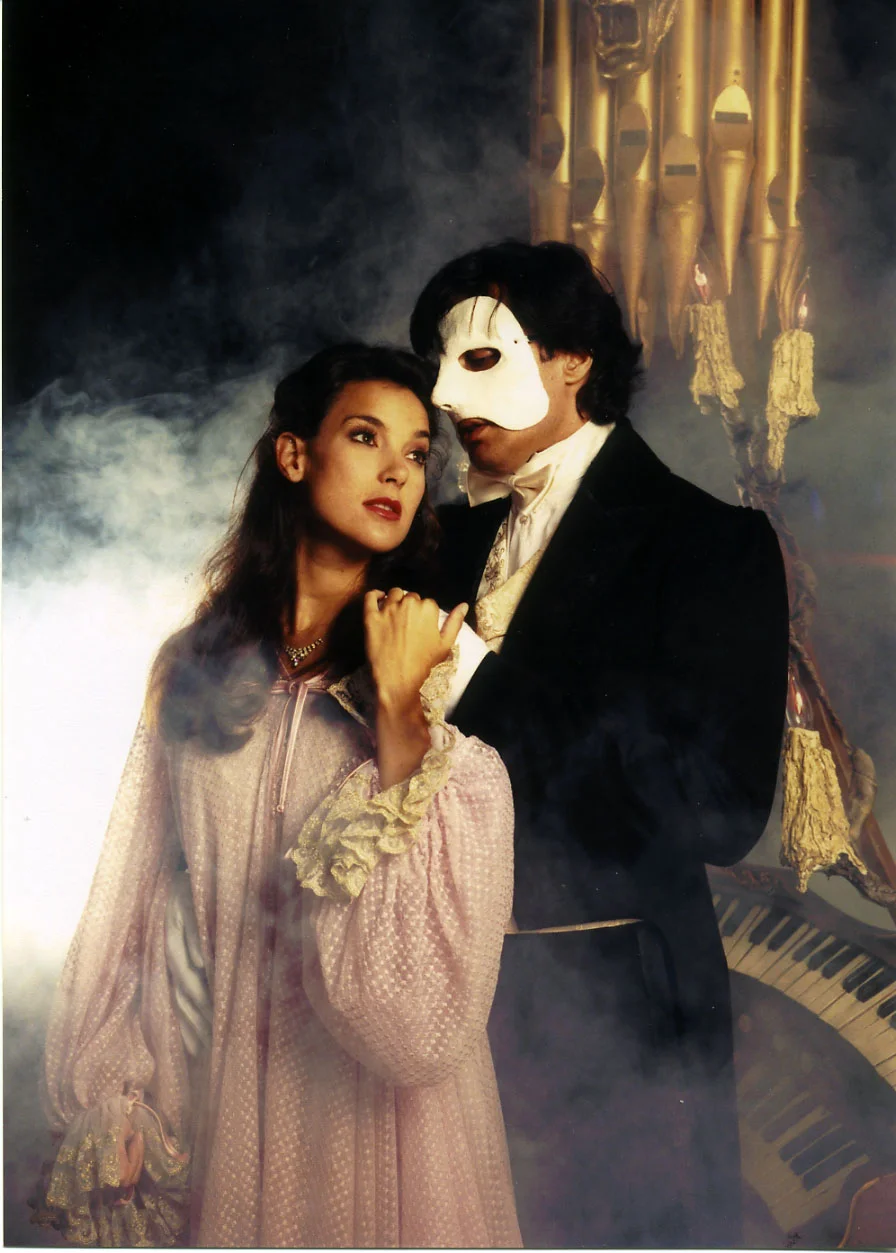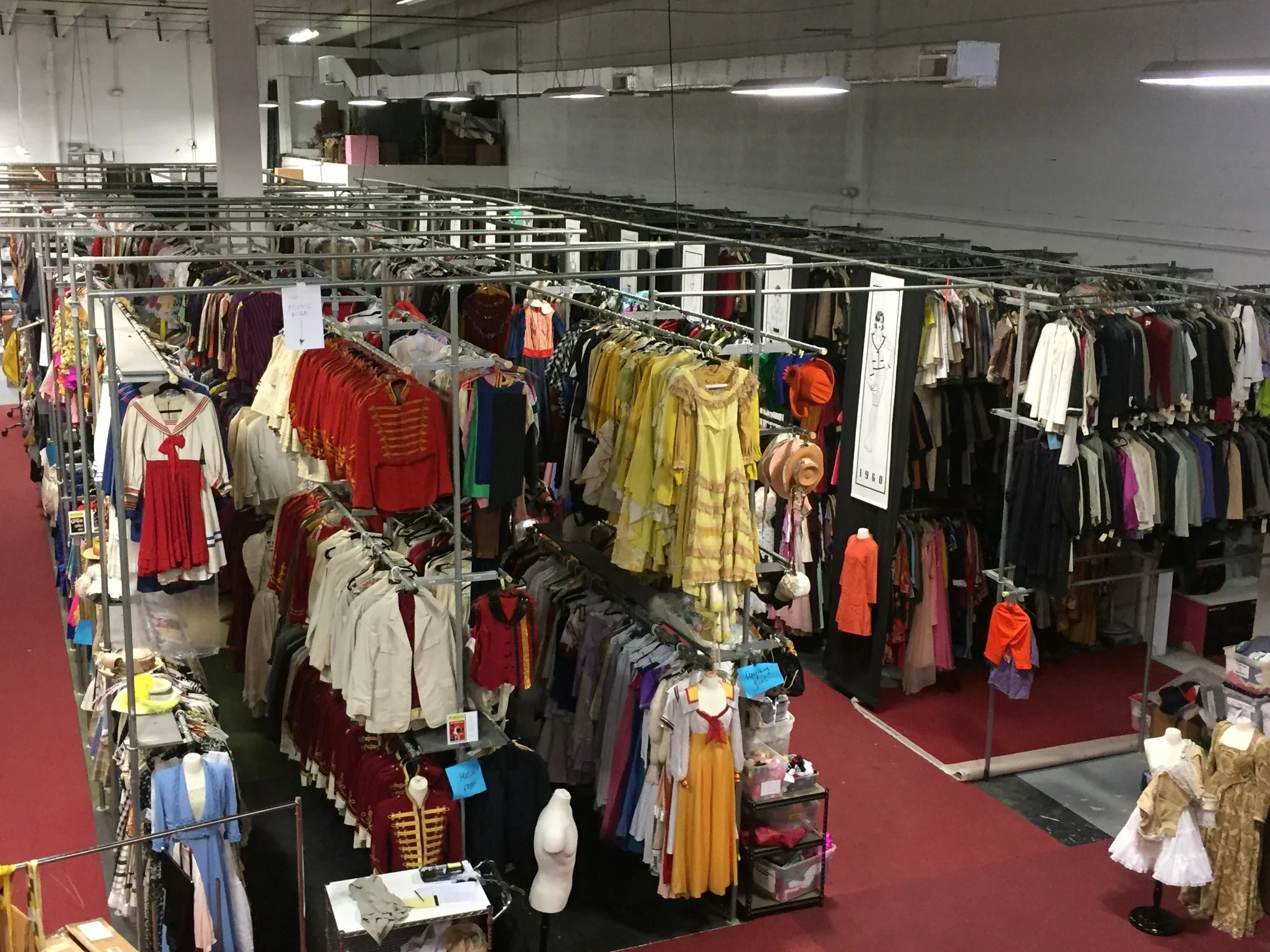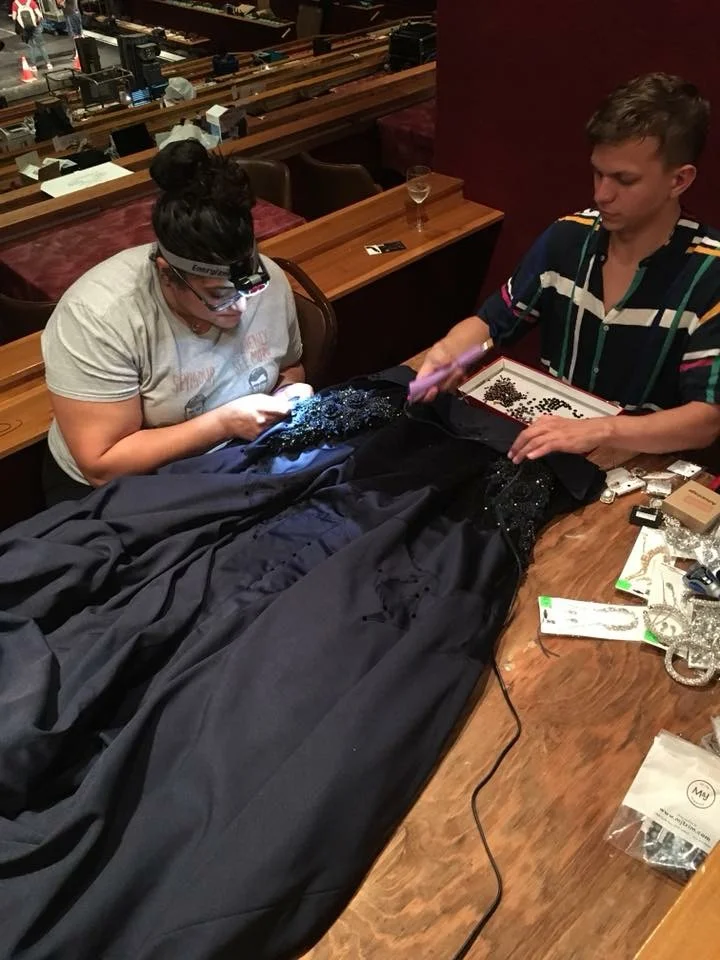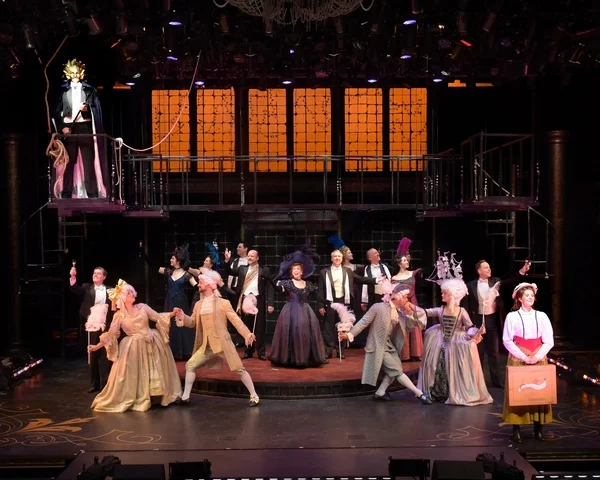PREFACE.
The Westchester Broadway Theatre has a rich history with the Yeston and Kopit version of Phantom . Producing the shows New York premiere in 1993, the show was scheduled to run for 9 weeks, it continued to run for 9 months. Every show was sold out, the theatre was even slightly renovated to be able to accommodate more seating.
Since I began working with the theatre several years ago I had heard many tales of the show , when it was added to their 2018 season I knew the show was going to be “big one” of the year. I had designed most of the season up until then and had grown to be a staple of the theatre, many bestowing the “resident designer” title upon me, however I knew that even such a title did not mean I booked the show. It happened rather naturally, I had just pulled our production of Anything Goes from the massive collection of Costume World in Florida, my schedule was wide open and….it just felt right for both the theatre and myself.
Two weeks later I was on a flight to Florida to pull together the spectacle that is PHANTOM.
RESEARCH.
Long before any garment makes it’s was to the stage and long before any fittings all projects start the same, with a script and a reader.As mentioned above I had heard many tales of this show, shortly upon starting my first read through of the script it was easy to see why, I could not put it down. So much inspiration, so many things I thought I knew from the more known Lloyd Webber version, so much passion.
A big part of my process when it comes to shows that have been done before or if I am paying homage to something is doing it honorably and respectfully. I also personally enjoy history and feel that knowing a shows history versus not definitely shows on stage.
I was provided with access to production photos from the theatre’s past 3 productions of this show, however I focused primarily on the original 90s production starring Robert Cuccioli and Glory Crampton. Listening to the cast recording of Glory Crampton’s voice as I read the script and then referencing visuals from that moment in time was incredible. I picked up on the romance of the story that is only accentuated by the backdrop of the grand Paris Opera. The setting of the story was a strong compass as I began developing my production.
DEVELOPMENT.
Developing my vision for the show was interesting, looking at what has been done in the past, respecting that but also making my own mark. I did not look at reference so much specifically but rather more broadly. I looked at many illustrations of the 1890’s period in France, being in France (especially in the opera) they had some of the best. Beautiful silk fabrics, dramatic sleeves, corseted waists all in the latest fashion. This is important to the arc of Christine, whom in this version grows up on a farm, comes to Paris to sell sheet music in the market only to find herself soon working in the Paris Opera. With that storyline you get to explore a full spectrum visually.
I pulled together a look book, cast sizes and off I was to pull the show in Costume World’s 45,000 square foot warehouse and costume shop.
Costume World’s Broadway Collection (this is just one quarter of the collection)
SELECTION PROCESS.
I always take the earliest flight when traveling so I do not lose the workday , so once I arrived I hit the ground running. Having a clear vision was very helpful when walking into an overwhelming collection (see photo below), with having a vision I knew which areas to focus on as well as what colors were within my palette. Our set was black with elements of burgundy and gold, I wanted pieces that would pop but also show the elegance of an evening in Paris, aka anything jewel tone became my best friend.
As I went along I draped many pieces to see how they draped, how they played with one another, this also helped to see what accessories or undergarments were needed. Now I would like to break down pulling a show a bit, as many people I encounter think it is very fun to pick out fabulous suits and fancy gowns…which it is however it is much more. Many things come into play, such as: silhouette, time period, weight, proportion, scale, size, feasibility to perform, number (matching ensemble looks), color, as well as the ability to fit into the full picture and play nicely next to several other costumes on the stage at the same time.
Additionally when pulling a show from scratch you are literally starting from scratch..that means it is one designer with a size chart and an empty rack, take this as well as the above information as well as the understanding of pulling every shirt, vest, accessory individually you don’t have as much time as you may think.
I spend 3 weeks pulling the show together, we had some casting delays and when I was waiting on size information I would go through each character individually and talk through the look alongside my shows breakdown to see what other characters were playing alongside it. All of this before anyone has even tried anything on however I believe that the success of a project is made in the preparation of it, when it comes to execution you already know and be able to execute with ease. After 2 of the 3 weeks I was still missing one (or three) key element(s)….THE CAPE. Our Phantom is 6’7 with shoes and the cape needs to be a full 360 degree cape that goes all the way to the floor, multiple people and countless hours of measuring, nothing was long enough or had the correct look. SO….WE MADE A FEW!
Christine “Melodie de Paris” Opening
La Carlotta Opening
Titania Fairy #1
DESIGN.
When you have a vision in your head sometimes it is hard to communicate that onto paper and how something communicates onto paper does not always communicate into the drape of a dress or in this case a cape. So building costume pieces naturally tends to make me lose some sleep but the opportunity to build pieces beckons back to my innocent childhood dreams.
I had found a full 360 degree cape in that I pulled to use to make a pattern as a base. At it’s core it is a pretty simple piece but I wanted to add some elements that highlighted both the period as well as the creativity of the character wearing it. This Phantom actually has 3 different capes, he has a standard two tiered black cape that is a mid weight and flows nicely but did not have the weight necessary to create the dramatic yet structured flow. So I knew I wanted something with some weight to it, which was solved with the fabric selection.
When it came to design I had seen some that had various embellishments on the collar which I felt made the neckline look cluttered, as with theatre we are also dealing with the aspect of distance both shirt and far. It is also in the costume plot that the Phantom has a formal cape (midnight blue) and a more “everyday” cape (black). The formal cape is how we meet the Phantom with his dramatic entrance to the stage and traditionally has some sparkle to it. I did not want to do two identical capes and just add stones to one of them. I wanted them to be related enough so that it was plausible for the same character to wear both but also show they had different functions.
Since I wanted to stay away from an embellished collar I decided on a raised embroidered edge yoke that highlighted the shoulders and framed both the face as well as filling the vast amount of fabric in the piece overall. Both capes had this same idea as far as construction however the black cape was black on black with black stitching, it is very subtle but is seen by closer audience members (Westchester has seating right on the edge of the 3/4 thrust stage so everything is visible) at minimum it helps in the characterization.
When it came to the design of the yoke I wanted it to reflect the story location as well as the character, so I boiled it down to a french renaissance man who appreciates the finer things. I looked at 19th century french renaissance patterns and I zoomed in very closely to the finer details, I pulled aspects of several patterns to create my sketch…which I played with and tweaked for DAYS.
Inspiration: Late 19th century french pattern
Original Phantom Cape Sketch *Differs slightly from finished product
BUILD.
Once I settled on a design and selected fabric it was time to pattern, cut and build. I had a master tailor work on the base cape pattern and cut while I played with the pattern of the yoke; adjusting my design scale from a small sketch to a “to scale” pattern.
“Casual Cape” yoke pattern
“Formal Cape” layered yoke pattern
Above is Robert who built the capes, he patterned, chalked and cut the pieces that were in both capes, rolled out all 4 fabrics (outer & lining). Most of the time was spent in the prep, aka measure twice cut once.
“Casual Cape” Construction
“Casual Cape” Construction 2
THEN….WE WAIT…AND SHOP.
Once I had the capes in an almost finished state I had to fly back up north as I was bringing along two capes for the sake of rehearsal as well as making space for the over 200 costumes, full costumes not individual pieces, that were soon to be arriving. While my production of Anything Goes was busy occupying most of the space with another 200 or so costumes…what can I say, I like extravagance.
Additionally I use this downtime for all of my shopping needs. Accessories, embellishments, shoes etc. I was not leaving any detail unnoticed and I had the time so I definitely wanted to take the opportunity to do so. I was not leaving one single potential page unturned.
Oh and how can I forget the wigs, I also met with our wig and hair designer to go through the show ending with 35 wigs in total.
Stones, Stones and more STONES
Mens tuxedo shoe by Stacy Adams; notice the fabric striping detail
FITTINGS AND TECH.
Out of respect for the privacy of my cast I will not be posting any fitting photos. My fittings spanned a minimum of 45 minutes, I brought in my stitcher for my principal fittings to ensure we caught every possible thing. I was so specific about everything which created a large bulk of alterations so I ended up sending out about 70 pieces to a shop in the city. Which made THE WORLD of a difference. For such a massive show I was EXTREMELY relaxed during tech. We also squeezed in an extra day which was a big help.
Most of my tech was absorbed in the “formal cape” which tech for me is ideally the finishing touches as I mentioned previously I feel a successful execution is in a thought out prep. The formal cape had some edits from above so the lining had to be switched and 4 days prior to opening had not one form of sparkle on it. For those whom have not stoned before each one has to be individually applied and I purchased over 2,000 stones. They also need to be applied firmly as the cape has some choreography and it is also a 4 month run, it needs to last.
Wardrobe Supervisor Rana stitches on floral appliqué to the shoulder while I apply the Swarovski stones individually.
Detail photo of the Phantoms “Formal Cape”
Finished cape, pretty fab if I do say so myself!
OPENING.
For this being the largest scale show I have done to date it was also my most relaxed opening to date as well and I credit that to my preparation and curiosity knowing that what was going out there was my truest and most genuine interpretation…in addition to being some of my best work. Our director Tom Polum brought in a fabulous photographer, Sam Fine, who documented and captured the grandeur of the show. Here are some of the photos he captured.
Dressing for the Night
Dressing for the Night
AND IN THE MIDDLE OF EVERYTHING….
Literally right in the middle of our opening matinee my assistant Alexandra scheduled a intermission meet and greet . It was a tad awkward to start but as audience members realized who I was they were all very sweet and complimentary. A great opportunity to both put a face to the name as well as explain the art and the process. Alex is also the mastermind of putting up one of Carlotta’s (reject) dresses in the lobby. Guests could take a photos with various props with the piece. I personally really enjoy this ensemble, it just didn’t make the cut, maybe next time.
Christine (Kayleen Seidl) arrives in Paris
Home, Kayleen Seidl as Christine and Matthew Billman as Phantom






























